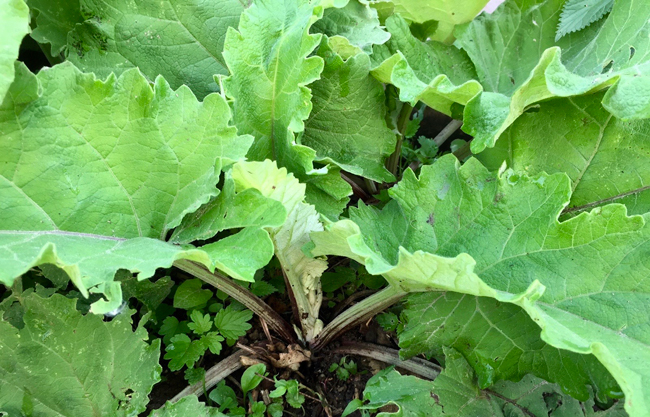
This post is sponsored by Chef Camp. Want to learn more about Chef Camp? Come down to the Fulton taproom tonight (Wednesday, July 12) — the Chef Camp team will be hosting a meetup and answering questions. The first 10 people to come say hi will get a free Chef Camp T-shirt!
Burdock plants are stunningly common. They’re regarded as an invasive species, and they’re also potentially a side dish for dinner.
“I’ve lately become obsessed with burdock,” writes Noah Barton. Barton is the camp cook for Chef Camp (he’ll be at both the Sept. 1-3 and Sept. 8-10 sessions), and is opening the Matty O’Reilly/J.D. Fratzke restaurant Delicata later this summer. “It’s an invasive species that is highly edible, so we can feel good about pulling it out of the ground by its roots. The whole plant is edible, even the burrs when they are young, although I’ve honestly only tried eating the root.”
“You can find it just about everywhere, I’ve been pulling it out of the yard at my mom’s house in Inver Grove Heights, but I see it all over in the parks in my neighborhood, especially around Minnehaha Falls.” (Editor’s note: Burdock can’t be removed from public land without a permit.)
“Burdock leaves basically look like rhubarb, but they aren’t as shiny as rhubarb leaves. They almost appear fuzzy. The roots can be really hard to get out of the ground, but they look like long, skinny white carrots when you do get them out. The flavor is slightly grassy, not unlike a woody version of a parsnip.” In its first year burdock is short, like rhubarb. In its second year, burdock growth has annoying burrs that catch on your clothes or get stuck in your dog’s fur. Those are the seeds that spread the plant everywhere. The roots are edible from both first- and second-year plants, but are smaller and more tender on first-year plants.
Barton adds that the recipe is an opportunity to make good use of an invasive species, and that if you’re hiking somewhere where its harvest is legal, it could be an ideal foraged food from the trail.
“One could make the dressing ahead of time and then head out with a shovel in tow,” he writes. “Upon returning to their campsite [foragers] could quickly peel and shred the roots using just a vegetable peeler and blanch them in boiling water before marinating. It’s like ‘one less thing to pack’ salad. Of course, you could also add other vegetables, carrots, cabbage, or whatever to the mix.”
Kathy Yerich contributed to this story.
SPICY BURDOCK SALAD
Noah Barton
Serves 4
12 ounces burdock root
¼ cup rice wine vinegar (seasoned)
2 tablespoons toasted sesame oil
½ tablespoon sambal oelek
1 teaspoon garlic, chopped
2 teaspoons lemon juice
2 teaspoons granulated sugar
1 teaspoon kosher salt
1. Combine rice vinegar, sesame oil, sambal, garlic, lemon juice, sugar, and salt and mix well. Set aside.
2. Wash burdock root well. Using a vegetable peeler, remove outer skin.
3. Use vegetable peeler to cut burdock into thin strips.
4. Blanch burdock in boiling salted water for 2 minutes, or until just tender.
5. Place blanched burdock into dressing mixture and allow to marinate for at least 30 minutes before serving.
